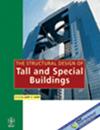Shape optimization of a corner‐recessed square tall building to reduce mean wind pressure using a multi‐objective genetic algorithm
IF 1.3
3区 工程技术
Q3 CONSTRUCTION & BUILDING TECHNOLOGY
引用次数: 0
Abstract
The current study aims to determine how the corner recession affects tall buildings with square plans. A series of numerical simulations have been conducted to find the parametric models' wind pressure. Visualization tools, such as contour plots and streamlines, present the wind flow near the buildings. Numerical simulations are conducted using RANS k‐ℇ turbulence models considering a length scale of 1:300. Subsequently, a shape optimization study has been carried out to propose a suitable percentage of corner recession, which should minimize the wind pressure on different faces of the building. As design factors, the amount of corner recession (S) and the wind incidence angle (Ø) are taken, along with the mean pressure coefficients (Cp) on the various building faces. Due to the eight axes symmetry of the building configuration, the random sampling technique is used for the Design of Experiment while accounting for the 0°–45° wind angle of attack. The Response Surface Approximation (RSA) is used to construct surrogate models of the objective functions. The RSA models are validated with wind tunnel test results presented in previously published articles. The optimization study is carried out using the multi‐objective genetic algorithm technique.应用多目标遗传算法优化方形凹角高层建筑的形状以降低平均风压
目前的研究旨在确定角落衰退如何影响方形平面的高层建筑。为了得到参数模型的风压,进行了一系列数值模拟。可视化工具,如等高线和流线,呈现建筑物附近的风流。数值模拟采用RANS k‐ℇ湍流模型,考虑1:300的长度尺度。随后,进行了形状优化研究,提出了合适的角落退行百分比,这应该最大限度地减少建筑不同面上的风压。作为设计因素,取角落度(S)和风入射角(Ø),以及各建筑表面的平均压力系数(Cp)。由于建筑的八轴对称结构,在考虑0°-45°风攻角的情况下,实验设计采用随机抽样技术。利用响应面近似法(RSA)构建目标函数的代理模型。RSA模型与先前发表的文章中的风洞试验结果进行了验证。采用多目标遗传算法进行优化研究。
本文章由计算机程序翻译,如有差异,请以英文原文为准。
求助全文
约1分钟内获得全文
求助全文
来源期刊
CiteScore
5.30
自引率
4.20%
发文量
83
审稿时长
6-12 weeks
期刊介绍:
The Structural Design of Tall and Special Buildings provides structural engineers and contractors with a detailed written presentation of innovative structural engineering and construction practices for tall and special buildings. It also presents applied research on new materials or analysis methods that can directly benefit structural engineers involved in the design of tall and special buildings. The editor''s policy is to maintain a reasonable balance between papers from design engineers and from research workers so that the Journal will be useful to both groups. The problems in this field and their solutions are international in character and require a knowledge of several traditional disciplines and the Journal will reflect this.
The main subject of the Journal is the structural design and construction of tall and special buildings. The basic definition of a tall building, in the context of the Journal audience, is a structure that is equal to or greater than 50 meters (165 feet) in height, or 14 stories or greater. A special building is one with unique architectural or structural characteristics.
However, manuscripts dealing with chimneys, water towers, silos, cooling towers, and pools will generally not be considered for review. The journal will present papers on new innovative structural systems, materials and methods of analysis.

 求助内容:
求助内容: 应助结果提醒方式:
应助结果提醒方式:


